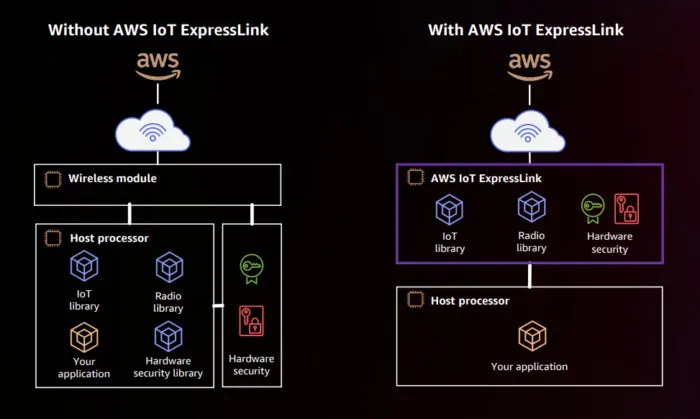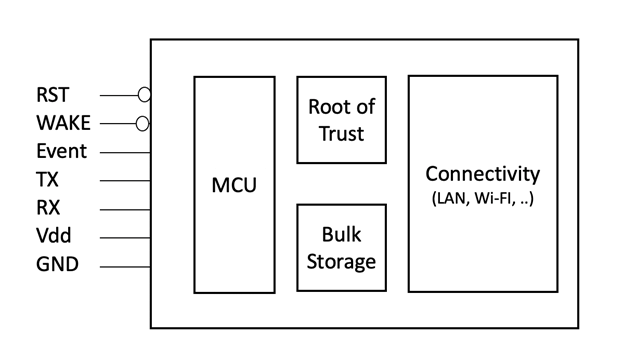Between competitive pressure, leadership demands, improved customer experiences and enhanced product value, there are many reasons why companies across industries connect products to the internet. In our increasingly connected world, businesses constantly strive to bring innovative products to market quickly, securely and efficiently.
However, connecting Internet of Things — or IoT — devices to the cloud can be a complex and challenging task. Enter AWS IoT ExpressLink. ExpressLink is software that powers hardware modules simplifying and accelerating the process of securely connecting IoT devices to Amazon Web Services — or AWS — at each product development life cycle stage.
As an AWS Specialization Partner and AWS Marketplace Seller providing end-to-end product design services for connected devices, we have significant experience using AWS IoT tools and understand the key benefits of using AWS IoT ExpressLink instead of redesigning with a new system on a chip (SOC) at each stage of the product development life cycle.
For a deeper dive into that topic, check out our recently published blog post on the AWS Partner Network (APN) blog detailing how we use ExpressLink to speed IoT product development.
Contents
Common Connected Device Development Challenges
With a constantly multiplying number of connected devices and a never-ending deluge of generated data complicating the ever-growing IoT, managed cloud services like AWS IoT Core allow devices to easily and securely interact with cloud applications and one another.
But connecting secure IoT devices to the cloud does not come without challenges that significantly impact a product’s time to market, cost and security. Across various stages of product development, IoT device design challenges can be broadly classified into two categories: technical and operational.
IoT Device Design Challenges
| Technical Challenges | Operational Challenges |
|---|---|
|
|
|
|
|
|
By addressing several common challenges — hardware integration and redesign, security implementation, cloud integration and communication, firmware updates and maintenance, and device provisioning and onboarding — AWS IoT ExpressLink accelerates the development life cycle of connected devices, reduces engineering efforts and ensures adherence to security best practices, ultimately enabling businesses to bring innovative IoT products to market faster and more cost-effectively.
Connecting an IoT Device to the Cloud With and Without IoT ExpressLink

When companies have a device they want to connect to the internet, adding AWS IoT ExpressLink is significantly easier than a complete redesign with a new SoC. ExpressLink simplifies and accelerates connecting a device to the cloud by providing preconfigured security features, managed services and streamlined integration with AWS IoT Core. This results in a more efficient, secure and scalable IoT development experience than connecting devices without ExpressLink.
Let’s dive into how AWS IoT ExpressLink’s connectivity modules can help rapidly identify and mitigate risks at different stages of the development process to reduce the time and engineering resources spent.
IoT Device Hardware Development
Hardware is often a limiting factor in IoT device development, as it manages critical tasks and functions, cost, power consumption, size and performance.
First, adding IoT ExpressLink to an existing device saves time and money since hardware redesign can be a lengthy and expensive process. Whether upgrading to a new SoC or adding new features or capabilities to a device, the hardware redesign process typically involves redesigning the printed circuit board (PCB) layout, routing the new board and other complexities that may introduce new issues or limitations that were not present in the original design.
With a more straightforward interface and fewer traces (see image below), AWS IoT ExpressLink removes the steps in integrating networking and cryptography layers, accelerating IoT product development while incorporating security best practices into the design.
AWS IoT ExpressLink Simplified Hardware Block Diagram

Since developers can add new connectivity features to devices without being forced to rework the underlying hardware, bolstering existing devices with AWS IoT ExpressLink is significantly more straightforward and less disruptive than a complete hardware redesign.
Developing Embedded Firmware
Determining each device’s functionality and behavior, the embedded firmware is critical to any internet-connected gadget.
Embedded firmware development is a complex and time-consuming process, often taking several months or even years, depending on the device’s functionality and performance requirements. Traditionally, connecting devices to the cloud required developers to integrate potentially complex external libraries to handle security and communication aspects, demanding in-depth networking and security knowledge.
AWS IoT ExpressLink simplifies this process by acting as a building block that helps devices establish a two-way connection with AWS IoT Core through native support of MQTT, enabling efficient communication for resource-constrained devices. With no need for fancy drivers, new hardware or debugging complicated communication protocols, developers can connect directly to the device with a couple of serial lines and API calls, making debugging the interface straightforward. AWS IoT ExpressLink modules natively support firmware updates, simplifying firmware updates on IoT devices in the field.
With ExpressLink, the firmware provisioning and onboarding process is more manageable, reducing the time and engineering resources required to ensure secure and reliable communication with the AWS cloud.
Ensuring Security and Compliance: AWS IoT Devices Manufacturing and Quality Assurance
As production volume increases, ensuring every connected device undergoes proper testing and meets quality standards while managing costs effectively becomes challenging. AWS IoT ExpressLink simplifies provisioning with cryptographically-secure preinstalled certificates, eliminating the need to generate, load, track and upload certificates onto devices.
The connectivity module includes software implementing AWS-mandated provisioning and security procedures, such as cryptographically-secure boot and over-the-air firmware updates, TLS v1.2 encryption and compliance with the security regression test suite. By featuring best practices for device-to-cloud connectivity and security, AWS IoT ExpressLink reduces the risk of vulnerabilities and errors during manufacturing, ultimately saving time and money.
Onboarding IoT Devices to the Cloud: Streamlining Device Authentication and Ownership
Cloud onboarding is complicated, from establishing secure data connections to verifying device authenticity, identity and ownership, organizing policies and permissions, managing and analyzing data, and triggering actions.
Despite the complexities, adding a compromised device to a cloud system is a mistake that can introduce security vulnerabilities that allow bad actors to access and manipulate sensitive data, spread malware to other devices in the network or cause damage to the system.
AWS IoT ExpressLink’s onboarding-by-claim feature helps streamline securely connecting devices to AWS IoT Core wirelessly, simplifying device authenticity and ownership. By easily associating physical devices with an AWS IoT Core “thing” in the cloud and adding them to an AWS IoT account, product engineers using ExpressLink effectively eliminate the need to set up extra cloud services or infrastructure.
Devices wait for end users to register the product and then move from the lobby to the cloud account. This implementation allows greater flexibility in the endpoint selection while minimizing exposure to third-party security breaches.
Unlocking IoT Success with Streamlined Prototyping
From hardware design through cloud onboarding, AWS IoT ExpressLink-powered connectivity modules provide the innovation, efficiency and speed at each stage to avoid costly hardware redesigns, simplify firmware, leverage preinstalled certificates, minimize the impact on manufacturing, offer provisioning options and enable efficient cloud onboarding by claim.
With AWS IoT ExpressLink, our IoT engineer experts were able to shave over six engineering months off the budget while improving the overall quality of the final product. Quickly transforming an embedded device into an IoT-connected device using AWS IoT ExpressLink speeds up time to market, lowers development costs and equips teams to focus on engineering elevated product experiences.
If you’d like to learn more about leveraging AWS IoT ExpressLink in your IoT product development journey, reach out to AWS IoT Partner Cardinal Peak.
